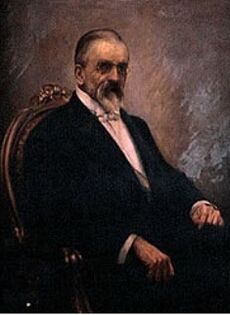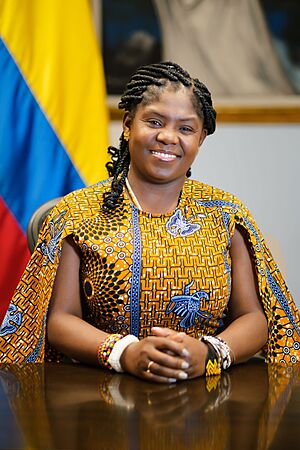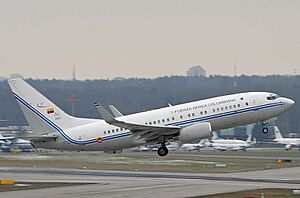Vice President of Colombia facts for kids
Quick facts for kids Vice President of theRepublic of Colombia |
|
|---|---|

|
|

Administrative seal
|
|
| Government of Colombia Executive Branch of Colombia |
|
| Style | Madam Vice President (informal) The Honorable (formal) Her Excellency (diplomatic) |
| Member of | Cabinet National Government National Economic Council |
| Residence | Vice Presidential House |
| Seat | Bogotá, D.C. |
| Appointer | Popular vote, or, if vacant, President via Constitutional |
| Term length | Four years, non renewable |
| Constituting instrument | Constitution of Colombia |
| Precursor | Presidential Designate |
| Formation | 17 December 1819 |
| First holder | Francisco Antonio Zea |
| Succession | First |
| Salary | Colombian pesos 15,900,569/US$ 4044,26 monthly |
| Website | vicepresidencia.gov.co |
The Vice President of Colombia is the second most important leader in the country's government. This person works closely with the President and is next in line to become president if something happens to the current one.
The Vice President is chosen by the people of Colombia through a popular vote. They are elected at the same time as the President for a four-year term. Since 1991, if the Vice President's position becomes empty, the President can appoint someone new.
Since the 1990s, the Vice President has an official home in Bogotá, D.C. called the Vice Presidential House.
It's important to know that the Vice President does not take over when the President is away on short trips or vacations. In those cases, the President usually asks a cabinet member, like the Minister of the Interior, to handle things.
If the Vice President is unable to serve, the Congress must meet to choose a new person for the role.
Currently, Francia Márquez is the 13th Vice President of Colombia. She started her term on August 7, 2022. She is the first Afro-Colombian person and the second woman to hold this important position.
Contents
History of the Vice President's Role
Early Beginnings
The idea of a Vice President in Colombia started with the Constitution of Cúcuta in 1821. This constitution said that if the President was temporarily or permanently absent, the Vice President would take over. The first President was Simón Bolívar, and Francisco de Paula Santander became the first Vice President.
Bolívar and Santander had different ideas about how the country should be run. While Bolívar was away fighting for freedom in other South American countries like Ecuador, Peru, and Bolivia, Santander was in charge. He worked to set up laws, organize the justice system, and improve education.
Bolívar did not always agree with Santander's actions. In 1826, Bolívar even suggested that the Vice President should be a very honest person, someone the President could trust.
Santander served until 1827. Later, in 1828, Bolívar decided to end the Vice President position and suspended the Constitution of Cúcuta. However, this change did not last long. In 1830, a new Congress met to create a new constitution.
Changes and Challenges
The Constitution of 1830 brought back the Vice President's role. General Domingo Caycedo, who was serving as Vice President at the time, even approved this new constitution.
However, Colombia was going through many changes, and a new constitution was written in 1832. This one changed how the Vice President was chosen. To avoid rivalries like those between Bolívar and Santander, the Vice President was elected two years after the President. This meant the Vice President would serve across two presidential terms. The Vice President also led the Council of State, which advised the President.
Between 1832 and 1858, Colombia faced several civil wars and changes in government. The Vice President's role was usually present. But in 1858, a new constitution, which favored a smaller government, removed the Vice President position. Instead, three appointed officials could replace the President if needed.
The Vice President's role was brought back in 1886 with a new, more conservative constitution. Rafael Núñez, a President at the time, used this role to his advantage.
The Modern Vice Presidency Emerges

One of the first Vice Presidents under the 1886 constitution was Eliseo Payan in 1886. However, he was quickly removed because his ideas did not match the President's. Miguel Antonio Caro then took the position. Many believed Caro was the real power behind the government, as President Núñez often stayed away from the capital. Caro continued to lead the country even after Núñez passed away in 1894.
After Caro, Manuel Antonio Sanclemente became President in 1898. He was quite old when he took office, and his time as President included the difficult War of the Thousand Days. Because the government was weak, the Vice President at the time, José Manuel Marroquín, was encouraged by others to take over. He did so in a coup on July 31, 1900.
After Marroquín, Rafael Reyes became President. At this time, the Vice President's position was respected and had significant political power, sometimes even balancing the President's power. However, in 1905, President Reyes, who wanted more control, ended the Vice Presidency and closed Congress. If the President was absent, ministers would choose a replacement. Even when the constitutional order returned in 1910, the Vice Presidency was not immediately brought back. The past disputes and the coup convinced Congress that it was better for the Legislature to appoint replacements for the President.
What the Vice President Does
Taking Over for the President
If both the President and Vice President are unable to serve, the Constitution of Colombia says that a government minister will take over the presidential office. This minister must belong to the same political party as the original President. They will serve as President until Congress chooses a new Vice President within 30 days, who will then become President.
Official Duties
According to a law from 2000, the Vice President's main jobs are:
- To carry out special tasks given by the President, following the Colombian Constitution.
- To advise the President on important topics like Human Rights and fighting corruption.
- To help the Colombian government manage international and national activities related to Human Rights and corruption.
- To plan ways to make sure different parts of the government work together on Human Rights and corruption issues.
- To represent Colombia in other countries when the President asks.
- To support and advise the President on other matters as determined by the President.
- To perform other duties as needed by the President.
Modern Responsibilities
The Vice President's actual power comes from tasks given to them by the President and Congress. These tasks can be very important. The Vice President's role often includes:
- Helping to write and explain government policies.
- Advising the President on important decisions.
- Representing the President and promoting unity.
The influence of the Vice President depends a lot on their relationship with the President and the specific government they are part of.
Becoming Vice President
Who Can Be Vice President?
To become Vice President, a person must be a natural-born citizen of Colombia and at least 30 years old. The Constitution of Colombia states that the Vice President must meet the same requirements as the President. There is no limit to how many times a person can serve as Vice President.
Office and Lifestyle
The Vice President's Home
The official home for the Vice President was finished in 1999. Gustavo Bell was the first Vice President to live there. Before this, Vice Presidents lived in regular houses, apartments, or hotels and received a housing allowance.
The Vice Presidential House has a modern and traditional design, including the family living area and a garden. It also has two older republican-style houses that serve as offices. The main entrance is on Calle 8va, with a unique water staircase. It was built between 1994 and 1999.
Travel and Transport
For long-distance air travel, the President and Vice President use special Boeing aircraft. These are modified Fokker F-28 planes. When the Vice President is on board, the plane is called "FAC-0002." While any plane from the Colombian Air Force can be used, these specific planes are often used for official travel. For international trips, sometimes two planes are used: a main one and a backup.
For shorter trips within Colombia, the Vice President can use helicopters from the Air Force. All travel is handled with strict security measures.
See also
 In Spanish: Vicepresidente de Colombia para niños
In Spanish: Vicepresidente de Colombia para niños
- List of vice presidents of Colombia
- Colombian presidential line of succession



